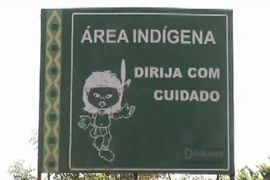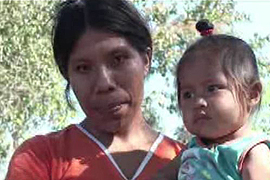Tragedy stalks Brazil’s Guarani
For this large indigenous group of people, loss of land is just one of many woes.

Despite being one of the largest indigenous groups in Brazil, the Guarani Indians have the smallest area of land and one of the highest suicide rates in the world.
A sign depicting an Indian sporting feathers on a dusty road in the country’s southwestern province of Matto Grosso do Sul, warns drivers they are cutting through an Indian reservation.
Inside the reservation many Guarani say they live in worse conditions than animals do.
Less than a hundred years ago all the land in the southern Matto Grosso do Sul, area belonged to the Guarani but today 40,000 of them are crammed into eight small reservations.
Many were expelled from their tribal lands 50 years ago and now have insufficient land to hunt, fish or plant the crops necessary to sustain themselves.
Teenage deaths
The conditions mean the Guarani can only grow basics such as potatoes and manioc, with the result that the average diet in the reservation is almost exclusively starch, causing rampant malnutrition, particularly among the young.
One couple and their large family are forced to survive with no beds, furniture or food and only “mate” tea to drink.
Making things worse, the couple’s 17-year-old son has just committed suicide. His father says “he was found hanging from a big tree”, but shows little emotion.
One of the couple’s neighbours, a sugar-cane cutter, is also coming to terms with suicide after his son and daughter hanged themselves, just the week before.
The boy was 17 and the girl 15. Their father said: “I don’t know … I thought they were okay, I went to work and the next thing I know I come home and they are dead.”
The teenagers’ deaths are not uncommon. At least 250 suicides have been reported among the Guarani in the last decade, and the rate is rising.
State pledge
One of the community leaders on the reservation, Marcos Veron, says the high suicide rate is directly linked to the loss of the Guarani’s traditional land.
 |
|
Malnutrition is common among children |
“Many young men and women are taking their own lives because they don’t have anywhere to live, to hunt, to practise our culture, to sing.”
The Brazilian president, Luiz Inacio Lula Da Silva, recently won re-election and one of his main campaign pledges was to improve the plight of his country’s poorest communities.
Brazil’s State Foundation for Indigenous Affairs says it is trying to give the Guarani back as much land as possible.
When asked how much land that means exactly, the foundation’s president, Mercio Pereira Gomez, said: “It’s as much as history will allow.
“It’s what history can do. Can the Celts regain their land in England? Can the American Indians regain the whole of the United States? Can the Aztecs expel the mestizos? No.”
Given that the region as a whole is now prime target for real-estate developers, it remains to be seen whether the government will be able to fulfil its pledge to indigenous communities.
If the history of Brazil’s indigenous people is any guide, the Guarani face a bleak future.
The total indigenous population did rise 150 per cent to 734,000 during the nine years to 2000, when the Brazilian government published its last census, butthis is still a long way off the estimated five million when Portuguese explorers arrived in 1500.
Over the centuries Indians have suffered enslavement, extermination campaigns, disease and neglect.